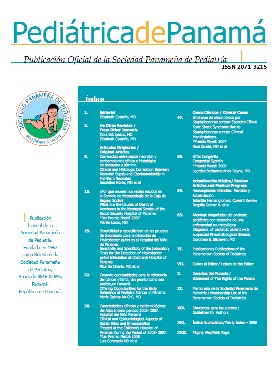Zika virus infection in Hospital del Niño “Dr José Renán Esquivel” (Panamá): Case Review since the introduction in Latin America
1,
1
Introduction: Zika virus Infection (ZIKV) is currently a major public health problem due to its possible sequelae in the newborn and related post-infectious complications. The introduction of the virus in Latin America took place in Brazil in 2015, since then it has been spreading throughout the rest of the continent in a progressive way. This article aims to analyze the experience of suspected clinical cases recorded in a pediatric third level facility until today.
Material and methods: An observational, retrospective study was carried out analyzing the epidemiological data of the suspected cases of ZIKV infection reported by the surveillance system of the Epidemiology Service at Hospital del Niño Dr. José Renán Esquivel from Panama in the period from January 2016 to December 2017.
Results: 156 patients were studied as suspected cases of ZIKV infection: 88 during the year 2016 and 68 during the year 2017. Of the 88 cases of the year 2016, 16 cases were classi ed as congenital Zika syndrome suspected cases with laboratory con rmation of the infection in only 5 cases. Of the 68 cases of the year 2017, were 35 classi ed as congenital Zika syndrome, with con rmed the infection in 6 cases.
Conclusions: In our sample, congenital Zika virus infection is not limited only to the presence of microcephaly, but there may be a wide variety of cerebral malformations associated with or without microcephaly. In addition, during these two years have been changing the diagnostic recommendations for detection of the virus in patients with suspected infection without achieving consensus in this regard, both in pregnant women and postnatal.
Show Affiliation
Authors
DOI:
https://doi.org/10.37980/im.journal.rspp.20181626Keywords:
Zika virus, Congenital Zika, Zika related Guillain Barre SyndromeAbstract
Abstract:Introduction: Zika virus Infection (ZIKV) is currently a major public health problem due to its possible sequelae in the newborn and related post-infectious complications. The introduction of the virus in Latin America took place in Brazil in 2015, since then it has been spreading throughout the rest of the continent in a progressive way. This article aims to analyze the experience of suspected clinical cases recorded in a pediatric third level facility until today.
Material and methods: An observational, retrospective study was carried out analyzing the epidemiological data of the suspected cases of ZIKV infection reported by the surveillance system of the Epidemiology Service at Hospital del Niño Dr. José Renán Esquivel from Panama in the period from January 2016 to December 2017.
Results: 156 patients were studied as suspected cases of ZIKV infection: 88 during the year 2016 and 68 during the year 2017. Of the 88 cases of the year 2016, 16 cases were classi ed as congenital Zika syndrome suspected cases with laboratory con rmation of the infection in only 5 cases. Of the 68 cases of the year 2017, were 35 classi ed as congenital Zika syndrome, with con rmed the infection in 6 cases.
Conclusions: In our sample, congenital Zika virus infection is not limited only to the presence of microcephaly, but there may be a wide variety of cerebral malformations associated with or without microcephaly. In addition, during these two years have been changing the diagnostic recommendations for detection of the virus in patients with suspected infection without achieving consensus in this regard, both in pregnant women and postnatal.
Downloads
Published
2020-11-09
Issue
Section
Case reports
License
Copyright (c) 2020 Infomedic InternationalDerechos autoriales y de reproducibilidad. La Revista Pediátrica de Panamá es un ente académico, sin fines de lucro, que forma parte de la Sociedad Panameña de Pediatría. Sus publicaciones son de tipo gratuito, para uso individual y académico. El autor, al publicar en la Revista otorga sus derechos permanente para que su contenido sea editado por la Sociedad y distribuido Infomedic International bajo la Licencia de uso de distribución. Las polítcas de distribución dependerán del tipo de envío seleccionado por el autor.






